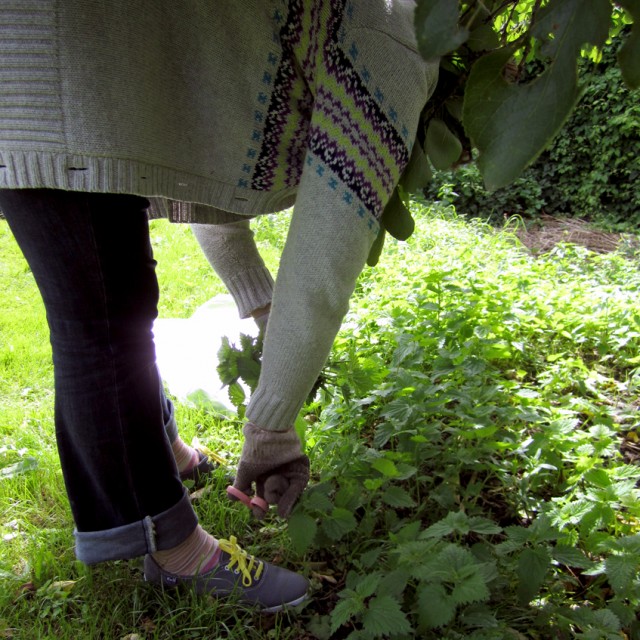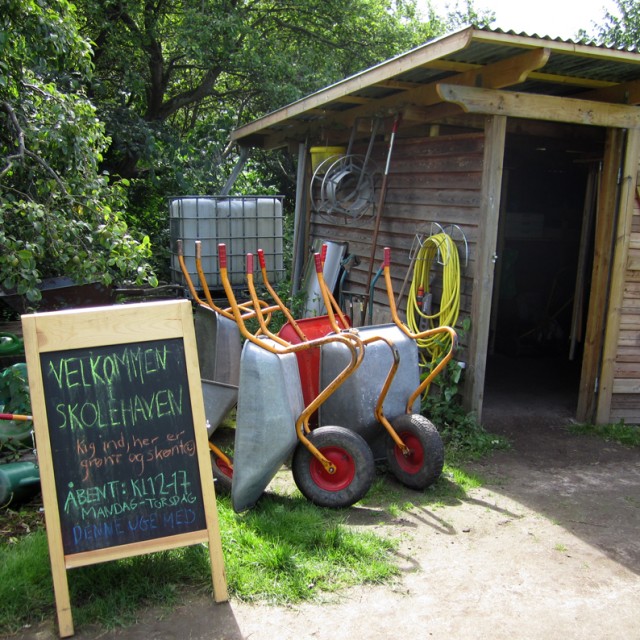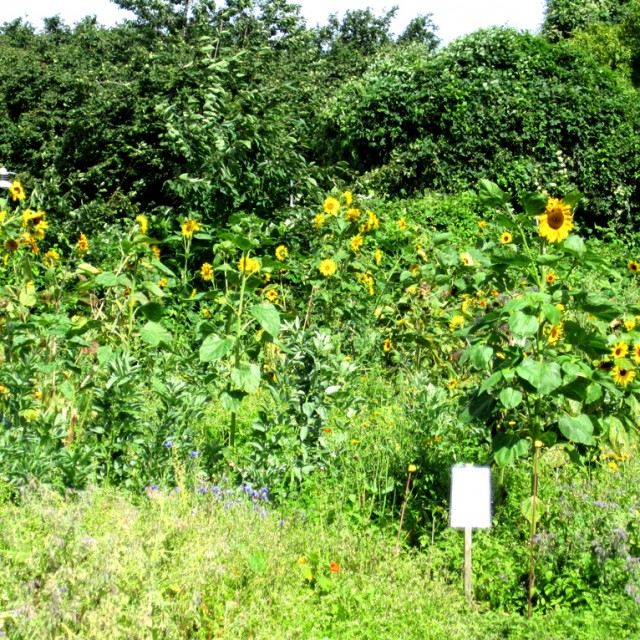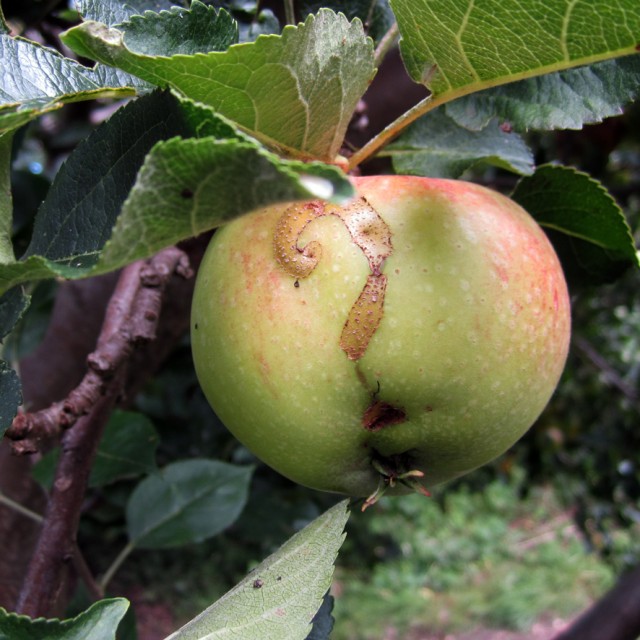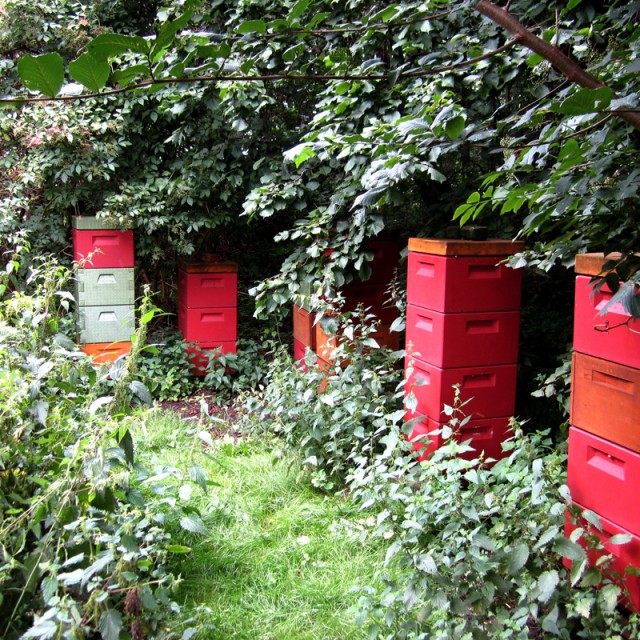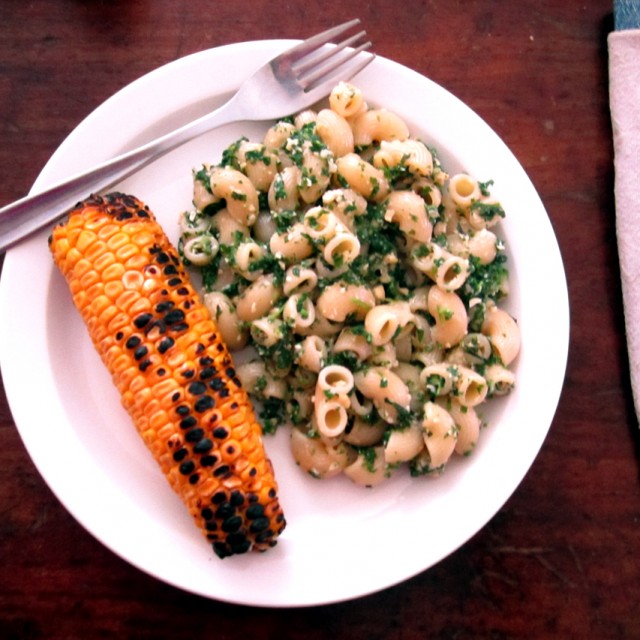Nettles from the school garden
The curmudgeonly stinging nettle is a secret softy. Despite its prickly exterior, which if grabbed too quickly will leave red welts on your hands, it is actually full of super healthy vitamins and minerals. Vitamins A and C, potassium, iron and calcium are all smooshed into the mildly spiky plant. We recently used nettles to make a kind of pesto to go over pasta–yum! But before I tell you how we did that, first a little about the amazing place where we found them in our city.
A few weeks ago, we went to visit Kopenhagens Skolehaver (school garden), an educational garden project just a few blocks north from where we live in Nørrebro (neighborhood of Copenhagen). The garden has been in the neighborhood since the late 1920s. It provides seeds, plots, and tools for school age children, as young as 1 or 2, to learn about how to cultivate plants. Spreading out over six hectares, it is tucked away next to a busy street and crisscrossing train lines. If you weren’t looking for it, you would not know it was there. It is open to the public so one can come in and walk around. When we visited, we were lucky to be guided by a garden teacher, Trine.
Trine showed us the various plots where she works with different groups of school children each day of the week. The young folks were growing potatoes, beets and sunflowers, among a large, overgrown mess of other things. At the end of each row, you can see the students names written on little signs. The school garden works with students from about twenty-five different schools in Copenhagen. They come often during the school year and spend several hours weeding and watering their plots.
The garden is divided into three main areas. To enter, you leave the sidewalk and duck under an overhang of vine-y trees. This instantly moves you into a non-city head space. Each successive area takes you further and further away from city streets behind you. Even though you know it’s there on the other side of the hedgerow, you forget about the city completely, once inside Skolehaver.
We followed Trine on the pathways that lead deeper into the garden. There are about five caretakers who manage the land along with students and volunteers. We passed apple trees, plum trees and nut trees, stopping to taste at each one. We talked with a student group who were excited about the new potatoes they had just dug up. We checked out the bee hives. We also checked out the chickens and bunnies, special friends of the school garden. The animals share fertilizer and educational opportunities for the visiting students.
During World War II, Trine told us, parents were happy that their children would bring home food when they came back from a day of learning at the garden. Today, Skolehaver still provides food to the students who tend their plots there, but the space also cultivates calm away from the busy environment of the city.
At the end of exploring this marvelous garden, Trine let us harvest some wild nettles. They were growing in the main garden underneath a tree. Perhaps nettles like shade? I have only found them under trees, so maybe this is true. We collected a plastic bag full and took them home with us to remember our trip to the garden.
This was our first time to cook nettles so we waited a week or so before eating them, while we figured out the best way to cook them. They kept very well in the refrigerator. Trine said she had made a particularly bitter soup with her nettle harvest, which she thought could have been avoided by blanching the nettles first. Other friends mentioned nettle tea, nettle pesto and nettle paste.
For our nettle feast, we ended up blanching the nettles and blending them with olive oil, salt, cashews and lemon in a food processor. Then we mixed them with pasta and some grated Parmesan cheese. It was so delicious and an excellent way to celebrate the history of Skolehaver.
I highly recommend trying out your own nettle recipe. Also, in case you were wondering, 6 hectares is approximately 14 acres.
Radio Aktiv Sonic Deep Map (2013)

SUPERKILEN – Extreme Neoliberalism Copenhagen Style

Read Brett's essay about the park.
Download our guide:

This is our guide to how-to books from the counterculture of the 60s and 70s. Click to get the download page.
Categories
- Agriculture (11)
- Animal sounds (1)
- Artist parents (19)
- Arts and culture (106)
- Bees (3)
- Book reviews (14)
- Books (18)
- Critical essays (5)
- Daily Photo (5)
- Design (36)
- Dirt (11)
- Environmental activism (43)
- Exhibitions (24)
- Farms (11)
- Forest (7)
- Friday connect (15)
- Growing (42)
- Habitat (38)
- Homesteading (16)
- Interviews (15)
- Kitchen (14)
- Living structure (9)
- MISC (15)
- Mythological (2)
- Neighborhood (83)
- Ocean News (1)
- Our Art Work (21)
- Personal – Design/Art (3)
- Play (2)
- Playground (4)
- Projects (21)
- Public space (53)
- Resilience (13)
- Sea Side (2)
- Sojabønner (2)
- Tofu (8)
- Vermont correspondence (7)
- Water (3)
- Wednesday picture (31)
- Workshop (1)
Video interview:

Watch our interview of SeedBroadcast, a mobile project that is part seed library and part seed-saving-story-collecting machine-recording the stories of seed saving, farming, and food sovereignty work being done around the US.

Download a poster Bonnie made about biodiversity in a vacant lot in the Amager borough of Copenhagen, in collaboration with biologist, Inger Kærgaard, ornithologist, Jørn Lennart Larsen and botanist, Camilla Sønderberg Brok: A BRIEF TAXONOMY OF A LOT

We made and installed a network of bat houses in Urbana, Illinois, to support the local and regional bat population, but also to begin a conversation about re-making the built environment.
READ MORE
BOOK REVIEW:

We write often about artists and art groups that work with putting ‘culture’ back in agriculture. Here is a new favorite: myvillages, a group of three women based in Germany, the Netherlands, and the UK. Read more...

Post Revolutionary Exercises
We really admire the dedicated hard work of Kultivator who seeks to fuse agriculture and art in their work. Click this sentence to get a PDF of their poster collection called "Post Revolutionary Exercises."

Cultural Practices Within And Across
This amazing book networks urban and rural resilience and sustainability projects around the world. Deeply inspiring projects in Romania, Paris, San Francisco, and elsewhere.
• Read our review of the book.
• Buy the book.
• Download the book.

